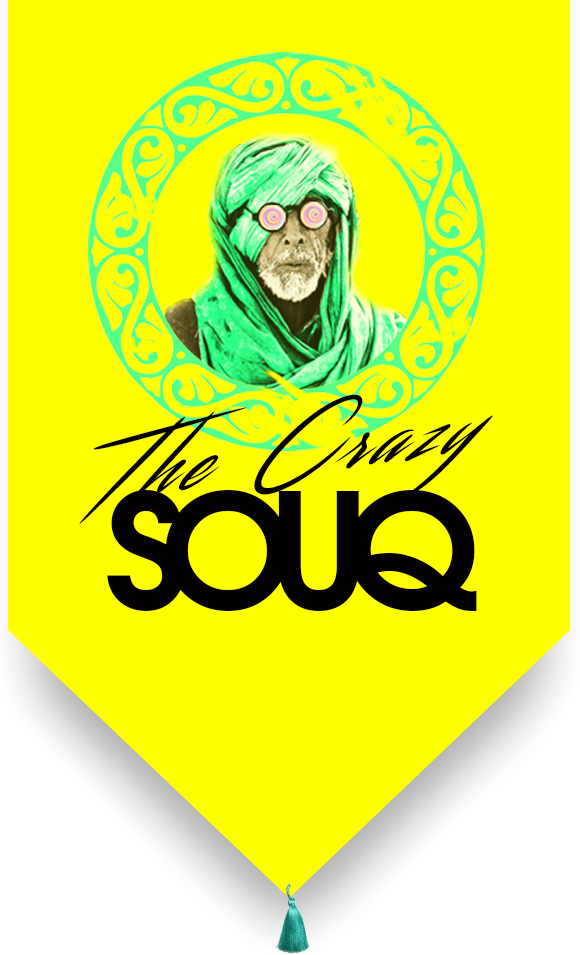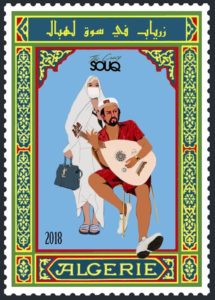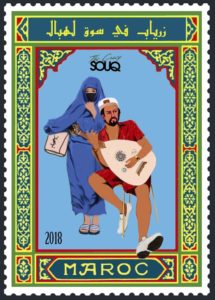His name is Abul-Hasan‘Ali Ibn Nafi’, popularly known at the time as Ziryab (would be @ziryabae on twitter and instagram), and is now called the Father of Andalusia. This manis a hidden gem in the pages of history, and if there’s anyone you need to know when discussing music, lifestyle, fashion and food in history, it’s this guy.
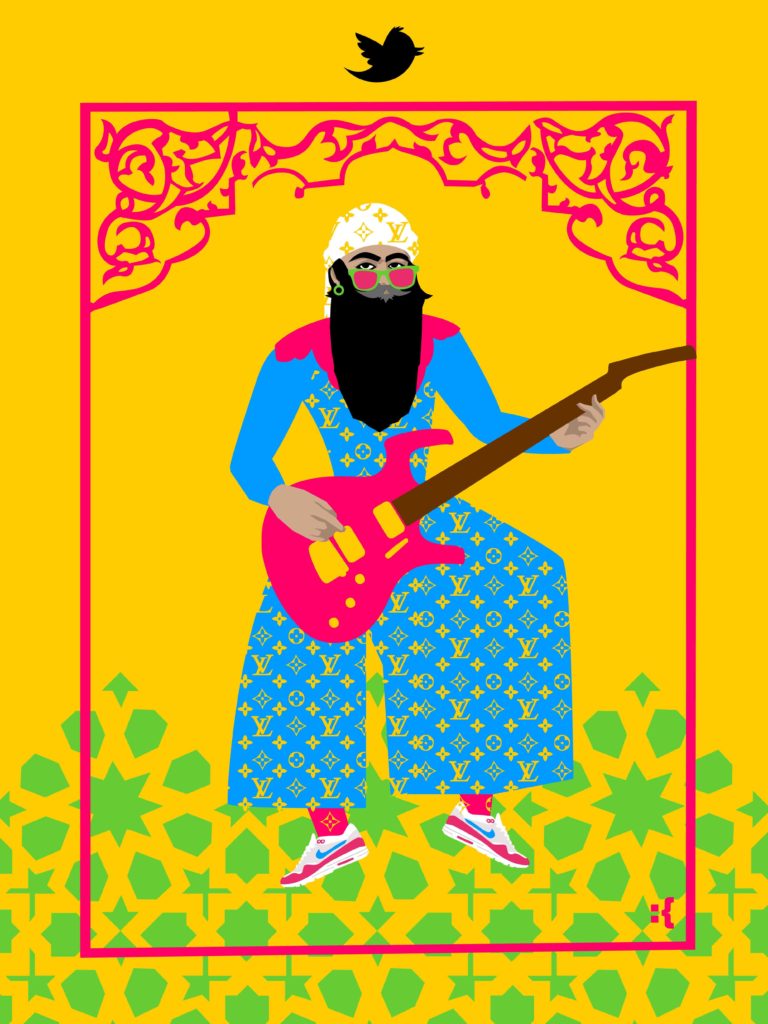
Ziryab in Louis Vuitton by EL MOUSTACHE exclusively!
Born in the year 789, Ziryab’s exact birthplace remains unknown. Historians have argued his origins for centuries, claiming him to be Arab, Persian, Kurdish, and African. It comes as no surprise that every group wants him to be of their own (personally, I like to think of him as weld el bled Algerian, it only makes sense with all his talent for music and fashion).
Hbibna Ziryab was the Cheb Khaled, the Fares from Samira TV, the Yves Saint Laurent of his time. He started off as a freed slave entertaining in the Abbasid court of Harun Al-Rashid, caliph of Baghdad. His popularity comes mainly from his astounding talent for writing and performing music; he is said to have over 1000 songs memorized by heart. His music was so good, other jealous court entertainers sent him into exile in North Africa, where he spent sometime in the courts of various leaders. It was his journey to his future home, Cordoba, Spain in 822 where he really made a name for himself.
- Ziryab fi El Djazair by L5YEL
- Ziryab fi El Maghrib by L5YEL
Ziryab bel goufa ta3ou f Aeroport Houari Boumediene: khoya khalini enjouz 3andi khadma ghodwa sbah ma3 elMalik ta3 sbanya.
Khadem ta3 Air Algerie: ma3lish ya jeune eftah gouftek enshoufou wesh 3andek.
Ziryab, not unlike most Algerians going to Europe with their goufa carry-ons filled with bags of potatoes and fresh cookies, would have pulled out the following, all of which he introduced to Europe and the court of Muslim Spain.
Here is a 7th century “what’s in mybag”!
Asparagus
One popular with the hajjas of the Maghreb and which shouldn’t come as a surprise to most, khodra men bled. Ziryab elevated the status of asparagus from weed to dinner speciality. He discovered the vegetable as edible and was the first to use it in a dish.
Soup, fish, meats, and dessert in that order!
He decreed that palace dinners would be served in courses, starting with a soup/appetizer, followed by fish, a meat main dish, and lastly a dessert. This then became popular with the rest of society, and is practised until today.
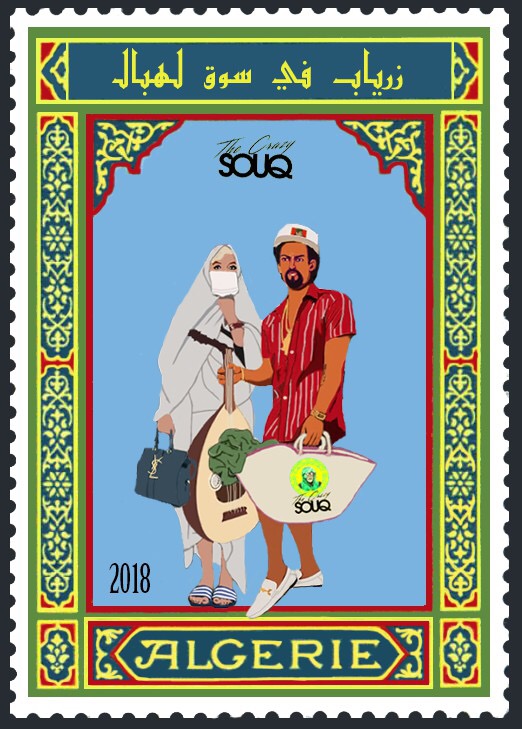
By L5YEL
His newly adjusted lute (also known as El Oud) with five strings instead of four
He introduced the lute to Spain and Europe, and is credited with Al-Kindi, the addition of a fifth bass string which changed the course of music in the Mediterranean. Not only is the lute’s sound popular with tradition Spanish and Andalusian music, but often heard in Chaabi Algerois, a genre near and dear to every Algerian heart. Records show that in regards to his lute, he has said, “My lute weighs about a third less than Ishaq’s, and my strings are made of silk that has not been spun with hot water which weakens them. The bass and third strings are made of lion gut, which is softer and more sonorous than that of any other animal. These strings are stronger than any others, and they can better with stand the striking of the pick.”
Soaps, deodorants, toothpaste, perfumes, cosmetics, and other toiletries
Ziryab was the first to use deodorants as a means of smelling nice in between baths, first to introduce toothpaste to the continent, and overall goes down as a hero to Europe for saving the people and their hygiene.
Hair cutting scissors and razors
Out with the irold, long and unkempt hairstyles, in with the new, shortly cut for men and bangs for women.With the new haircuts, people of the time enjoyed his formula of rose water and salt shampoo.
It’s safe to say that he didn’t get too many complaints from his dates, his well kept hair andhygiene certainly couldn’t hurt.
Silver ware and glass cups
Bringing with him some Islamic traditions, he switched the old European practice of drinking out of goblets and eating with gold ware with lighter and (opinion: more tasteful) glass drinking cups and silver ware.
Tablecloths
An import and addition to any table setting, and personally my favorite item on the shopping list in the souk back home in Algeria, Ziryab brought to Europe’s blank, rough, and uncovered wooden tables tasteful
Recipe books
Ziryab took advantage of the wide variety of new ingredients introduced to him in Andalusia by combining them to make delicious new dishes. Many dishes he came up with are still named after him, like taqliyat ziryab (a meat ball and coriander oil fried triangular dough dish) and ziryabi (roasted, salted bean dish). Zalabia, a popular Algerian fried batter pastry dipped in saffron syrup dessert, is believed to have been a Ziryab original recipe which he developed during his stay in Algeria! He brought the dish to Spain, which later made its way across the world to India in the 15 century as Jalebi. He also came up with the delicious snackof eating walnuts and honey, still popular in the city of Zaragoza.
Chess and polo boards
The first time the popular games of Chess and Polo were ever played was in the Cordoba court, where Ziryab taught court dwellers its rules and spread as a common past-time for the elite.
Winter and Summer dresses
He made stylish the wearing of white and light colored linens and cottons in the summer, furtrimmed coats in the winter,and colorful silks which represented the season in which one wore them (bright, flower resembling colors in the spring, and reds/oranges/yellows during the fall).
The time Ziryab spent in Andalusia, refashioning and bringing great change to Europe, contributed to the greatest and most peaceful time period the Spanish peninsula has ever seen. Andalusia was a time in which Muslims, Christians, and Jews lived in harmony together, creating great strides in mathematics, physics, astronomy, art, music, and general culture. They united in a convivencia or “living-together” characterized by tolerance and cooperation, unseen in Europe’s history. It is important to look back in history at a man like Ziryab, whoencouraged this solidarity along with his fashion tips, recipes and mannerisms, and take away as a lesson to apply in today’s world.
Son nom est Abul-Hasan ‘Ali Ibn Nafi’, connu à son époque sous le nom de Ziryab (ça serait @ziryabae sur Twitter et Instagram), et maintenant appelé en tant que le Père de l’Andalousie. Cet homme est un des joyaux cachés dans les pages de l’histoire, et s’il y a une personne que vous devez connaître quand vous parlez musique, lifestyle, mode ou gastronomie dans l’histoire, c’est lui.

Ziryab in Louis Vuitton by EL MOUSTACHE exclusively!
Né en 789, le lieu de naissance de Ziryab est jusqu’aujourd’hui inconnu. Les historiens se disputent depuis des siècles quant à son origine, le revendiquant Arabe, Perse, Kurde, ou Africain. Ce n’est pas une surprise que chaque groupe le veut pour soi (personnellement, j’aime le penser weld el bled Algérien, ça tombe sous le sens vu son talent pour la musique et la mode).
Hbibna Ziryab était le Cheb Khaled, le Fares de Samira TV, l’Yves Saint Laurent de son temps. Il a commencé en tant qu’esclave libre divertissant la cour abbaside de Haroun al-Rachid, calife de Bagdad. Sa popularité provient en grande partie de son surprenant talent pour l’écriture et interpréter la musique ; il aurait connu plus de 1 000 chansons par cœur. Sa musique était telle que d’autres divertisseurs de cour jaloux l’ont exilé en Afrique du Nord, où il resta quelques temps dans les cours de divers dirigeants. Cependant c’est bien lors de son voyage vers ce qui sera sa future maison, Cordoue (Espagne) en 822 qu’il s’est fait un nom.
- Ziryab fi El Djazair by L5YEL
- Ziryab fi El Maghrib by L5YEL
Ziryab bel goufa ta3ou f Aeroport Houari Boumediene: khoya khalini enjouz 3andi khadma ghodwa sbah ma3 elMalik ta3 sbanya.
Ziryab avec son sac à l’aéroport Houari Boumediene : mon frère laisse moi passer j’ai du travail demain matin avec le roi d’Espagne.
Khadem ta3 Air Algerie: ma3lish ya jeune eftah gouftek enshoufou wesh 3andek.
L’employé d’Air Algérie : c’est pas grave jeune, ouvre ton sac qu’on voit ce que t’as.
Ziryab, contrairement à la plupart des Algériens allant en Europe avec leur goufa remplie de sacs de pommes de terre et de cookies, aurait sorti les éléments suivants, tous introduits par lui en Europe et à la cour de l’Espagne musulmane. Voici un « what’s in my bag » version 7e siècle !
L’asperge
Connu par les hajjas du Maghreb et ce qui ne devrait pas être une surprise pour la plupart, khodra men bled. Ziryab a élevé le statut d’asperge de plante à spécialité de dîner. Il a découvert que le légume était comestible et a été le premier à l’utiliser dans un plat.
Soupe, poisson, viandes, et dessert dans cet ordre !
Il a décrêté que les dîners de palaces devraient être servi par plats, commençant par une soupe/un apéritif, suivi par du poisson, un plat principal comprenant de la viande, et enfin un dessert. Par la suite, cela est devenu populaire auprès du reste de la société et est pratiqué jusqu’à aujourd’hui.

By L5YEL
Son nouveau luth ajusté (aussi connu comme Al Oud) avec cinq cordes au lieu de quatre
Il a introduit le luth en Espagne et en Europe, et il est crédité avec Al-Kindi de l’ajout d’une cinquième corde basse qui a changé le cours de la musique en Méditerranée. Non seulement le son du luth est populaire dans la musique espagnole et andalouse traditionnelle, mais il est également souven entendu dans le châabi algérois, un genre proche et cher à tous les cœurs algériens. Les archives montrent que quant à son luth il a dit « Mon luth est plus léger d’environ un tiers quant à celui d’Ishaq, et mes cordes sont faites de soie qui n’a jamais été filé par de l’eau chaude qui les affaiblit. La basse et troisième cordes sont faites d’intestin de lion, plus doux et plus sonore que celui de tous les animaux. Ces cordes sont plus fortes que toutes, et elles peuvent mieux supporter la frappe du médiator. »
Savons, déodorants, dentifrices, parfums, cosmétiques, et autres articles de toilette
Ziryab est le premier à avoir utiliser des déodorants pour sentir bon entre les douches, le premier à introduire le dentifrice au continent, et de manière générale apparaît comme un héros en Europe pour avoir sauvé son peuple et leur hygiène.
Les ciseaux pour couper les cheveux et les rasoirs
Au revoir les coupes longues et mal coiffées, place aux nouvelles coupes courtes pour les hommes et aux franges pour les femmes. Avec leurs nouvelles coupes, les gens de son époque ont profité de sa formule à l’eau de rose et au shampooing au sel.
Il est sûr qu’il n’ait pas reçu beaucoup de plaintes à son égard, ses cheveux bien coiffés et son hygiène n’ont sûrement pas fait de mal.
Argenterie et coupes en verre
Apportant avec lui quelques traditions musulmanes, il changea l’ancienne pratique européenne consistant à boire à partir de gobelets et manger avec des couverts en or par une argenterie beaucoup plus légère (opinion : de meilleur goût) et des coupes en verre.
Nappes de table
Importation et ajout à n’importe quelle disposition de table, et personnellement mon article préféré sur la liste d’achats au souk à la maison en Algérie, Ziryab a apporté aux tables en bois non-couvertes et rugueuses d’Europe de belles nappes.
Livres de recette
Ziryab a profité de la large variété des nouveaux ingrédients qui lui ont été introduit en Andalousie pour les combiner et créer de nouveaux plats délicieux. Beaucoup de plats qu’il a créé sont encore nommé après lui comme taqliyat ziryab (des beignets triangulaires de boulettes de viande et coriandre frits) et ziryabi (haricots salés rôtis). On pense que la zalabia, pâte à frire algérienne trempée dans du sirop de safran, un dessert populaire algérien, est une recette originelle que Ziryab aurait développé lors de son séjour en Algérie ! Il a ramené le plat en Espagne, trouvant plus tard son chemin vers l’Inde au 15e siècle en tant que Jalebi. Il a également eu l’idée du délicieux apéritif consistant à manger des noix et du miel, toujours populaire dans la ville de Saragosse.
Planches d’échecs et de polo
La première fois que les jeux populaires d’échecs et de polo, ont été joué, ce fut à la cour de Cordoue lorsque Ziryab apprit aux courtisans les règles et que ces jeux sont devenus un passe-temps banal pour l’élite.
Robes d’hiver et d’été
Il a rendu élégant le port de lin et cotons blancs et clairs en été, de manteaux à fourrure en hiver et de soies colorées qui représentaient la saison dans laquelle on les portait (des couleurs vives et rappelant les fleurs au printemps et du rouge, orange ou jaune à l’automne).
Le temps que Ziryab a passé en Andalousie, refaçonnant et amenant de grands changements en Europe, a contribué à une des périodes les plus grandes et les plus paisibles que la péninsule espagnole ait jamais vu. L’Andalousie était un temps où Musulmans, Chrétiens, et Juifs vivaient ensemble en harmonie, créant de grands progrès en mathématiques, physiques, astronomie, art, musique, et culture générale. Ils se sont unis dans une convivencia, ou « vivre ensemble » caractérisé par la tolérance et la coopération, chose inconnu dans l’histoire de l’Europe. Il est important de revenir en arrière dans l’histoire et regarder un homme comme Ziryab qui a encouragé cette solidarité avec ses conseils de mode, recettes et maniérismes, et d’emporter tout cela comme une leçon à appliquer dans le monde d’aujourd’hui.
اسمه أبو الحسن علي بن نافع، المعروف شعبيا في ذلك الوقت بزرياب ويسمى أب الأندلس. هذا الرجل هو جوهرة خفية في صفحات التاريخ، وإذا كان هناك أي شخص تحتاج إلى تعرفه عندما تناقش الموسيقى، نمط الحياة، الأزياء أو الأكل فهو هذا الشخص.

Ziryab in Louis Vuitton by EL MOUSTACHE exclusively!
ولد في عام 789، زرياب مكان ولادة بالضبط لا يزال مجهولا. وقد جادل المؤرخون أصوله لعدة قرون، مدعيا أنه عربي وفارسي وكردي وأفريقي . ليس من المستغرب أن كل مجموعة تريد له أن يكون من تلقاء نفسها (شخصيا، أنا مثل أن يفكر منه كما لحام بليد الجزائري، إلا أنه يجعل من المنطقي مع كل ما قدمه موهبة للموسيقى والأزياء).
حبيبنا زرياب هو الشاب خالد لزمانه، فارس من تلفزيون سميرة، ايف سان لوران في ذاك الوقت. بدأ كرقيب متحرر مسرحي في المحكمة العباسية في عهد هارون الرشيد خليفة بغداد. شعبيته تأتي أساسا من موهبته المذهلة للكتابة وأداء الموسيقى. وقيل أنه يحفظ أكثر من 1000 أغنية عن ظهر قلب. كانت موسيقاه جيدة جدا، وأرسله آخرون من الفنانين الحاسدين إلى المنفى في شمال أفريقيا، حيث قضى بعض الوقت في أفنية مختلف القادة. كانت رحلته إلى منزله في قرطبة بالاندلس (إسبانيا حاليا) في 822م حيث جعل حقا إسما لنفسه.
- Ziryab fi El Djazair by L5YEL
- Ziryab fi El Maghrib by L5YEL
–زرياب بالقفة نتاعو في مطار هواري بومدين : خويا خليني نجوز عندي خدمة غدوة صباح مع الملك نتاع إسبانيا .
–الخدام نتاع الخطوط الجوية الجزائرية : معليش يا جان أفتح قفتك نشوف واش عندك .
زرياب ليس مثل بقية الجزائريين الذاهبين إلى أوروبا مع قفاتهم المليئة بأكياس البطاطا و الحلويات، كان ليحملها و يقدمها إلى أوروبا و نظام الحكم الإسلامي في إسبانيا . هنا القرن السابع ” ماذا يوجد في حقيبته !”
الهليون : مشهور مع هجاس يعوظ إلى المغرب و الذي لا يظهر للجميع، خضرة من البلاد
. زرياب وضع الهليون في مقام رفيع من الحشيش مخصص للعشاء، إكتشف أنه قابل للأكل و كان الأول الذي إستعمله في طبق .
الحساء، السمك، اللحم و التحلية بهاذا الترتيب !
أصر على أن العشاء في القصور يجب أن يوزع في حصص بداية من الحساء متبوعة بالسمك، اللحم كطبق رئيسي و أخيرا التحلية . بعد ذلك أصبح هذا الترتيب مشهورا في المجتمع حتى يومنا هذا ألته العود الجديدة بخمسة أوتار بدلا من أربعة لقد عرف هذه الألة إلى إسبانيا و أوربا و تقيده بالكندي، إضافة خمسة أوتار للألة الموسيقية غير الموسيقى في منطقة البحر الأبيض المتوسط، ليس صوت العود مشهور في التقاليد الإسبانية و الأندلسية فحسب و لكن أحيانا في الموسيقى الشعبية الجزائرية، موسيقى حبيبة على كل القلوب الجزائرية. الشائعات تقول أنه قال عن ألته العود “آلة العود تزن ثلاث أضعاف أقل من إسحاق، أوتارها مصنوعة من السلك الذي لم يسقل بالماء الدافئ ما يجعلها ضعيفة. الوتر الرئيسي و الثالث مصنوعة من أحشاء الأسد و هي ناعمة الملمس و رنانة أكثر من أي جزء من حيوان أخر.هذه الأوتار أقوى من أي أوتار أخرى و يمكنها أن تصبح أفضل.

By L5YEL
الصابون، مزيل العرق، معجون الأسنان، العطور، مواد التجميل و غيرها من المواد المشابهة
زرياب كان أول من إستعمل مزيل العرق حتى تكون له رائحة عطرة أثناء الإستحمام، أول من عرض معجون الأسنان في القارة
حتى أصبح بطل أوربا في إنقاذ الناس و نظافة أجسادهم.مقاص و أدوات الحلاقة: أخرجت قصات شعر مختلفة، مع الشعر القصير للرجال و تسريحات الدوي للنساء. مع هذه التسريحات إستمتع الناس بماء الزهر، شامبو و ملح الإستحمام. من الجيد قول أنه لم يتلقى أي شكوى من هذا، شعره و نظافته لم يؤذيا أحد.
الأواني الفضية و الكؤوس الزجاجية:
أحضر معه بعض العادات الإسلامية و حول العادات الأوربية القديمة من أواني للشرب و الأكل إلى أواني ذهبية و أكثر لمعانا ) وجه نظر: أكثر قابلية للتذوق( كؤوس زجاجية و أواني فضية.
غلاف الطاولات:
من أهم إعدادات أي طاولة و شخصيا أداتي المفضلة في لائحة التسوق في السوق الجزائرية، زرياب أحضر إلى أوربا الطاولات الخشبية الصافية و الصلبة.
كتب الطبخ:
أخذ زرياب فائدة كبيرة من المكونات التي قدمت له في الأندلس بمقارنتها لإعداد أطباق جديدة و لذيذة. الكثير من الأطباق الجديدة
التي أتى بها سميت عليه مثل: تقليات زرياب و هي عبارة عن كرات من اللحم و الكزبرة مقلية بالزيت في شكل مثلثات و توضع في طبق، و كذلك طبق الزريابي و هو عبارة عن فول مشوي مملح. الزلابية و التي تعتبر من أهم الحلويات الجزائرية الطلية بالزعفران و المقلية، يصدق أنها واحدة من وصفات زرياب التي طورها خلال فترة بقائه في الجزائر! أخذ الطبق إلى إسبانيا و الذي أخيرا إنتقل حول العالم إلى الهند في القرن 15 تحت إسم جالابية. أتى زرياب أيضا بفكرة التحلية اللذيذة جوز البندق بالعسل لا يزال الطبق مشهورا في مدينة زاراقوزا.
الجبن و ألواح البولو:
أول مرة لعبة الشطرنج المشهورة و رياضة البولو تم لعبها أول مرة في قرطبة حيث علم زرياب السكان قواعد اللعب و نشر نخبة
مؤلوفة.
فساتين الصيف و الشتاء:
صنع ملابس أنيقة من اللون الأبيض و الألوان الفاتحة مصنوعة من القطن للصيف، و معاطف الفرو للشتاء و حرائر ملونة تمثل
الفصول ) ألوان فاتحة، أشكال الزهور تمثل فصل الربيع، الألوان الأحمر، البرتقالي و الأصفر لفصل الخريف(. الوقت الذي قضاه زرياب في الأندلسية طور الموضة و أحضر تغيرات للقارة الأوربية، تعد هذه الفترة من أفضل الفترات في تاريخ
الأندلس و أكثرها سلاما. الأندلس في وقت ما عاش بها المسلمين، المسيحين و اليهود في كل سلم و أمان، حيث طوروا الرياضيات، الفيزياء، الفلك، الفن و الثقافة العامة. وحد هؤلاء طريقة للعيش مع بعضهم البعض كان مشخصة بالتسامح و التعاون عكس أوربا. من المهم النظر من جديد إلى التاريخ و الإطلاع على رجل مثل زرياب الذي شجع هذا التناغم بأسلوبه في الموضة، وصفاته .
